Abstract
Membranes of mouse L cells that contain adenylate cyclase [ATP pyrophosphate-lyase (cyclizing), EC 4.6.1.1] but lack beta-adrenergic receptors have been solubilized with Lubrol 12A9. Addition of such adenylate cyclase-containing extracts to beta-adrenergic receptor-replete membranes from adenylate cyclase-deficient S49 lymphoma cells results in the production of a catecholamine-sensitive adenylate cyclase system. The effects of beta-adrenergic agonists and antagonists on the reconstituted system reproduce those that are characteristic of the wild-type S49 lymphoma cell. The uncoupled variant of the S49lymphoma contains adenylate cyclase, but donor extracts from this clone fail to reconstitute the hormone-sensitive enzyme activity when added to adenylate cyclase-deficient membranes. Thus, the uncoupled and adenylate cyclase-deficient variants of the S49 cell are not complementary.
Full text
PDF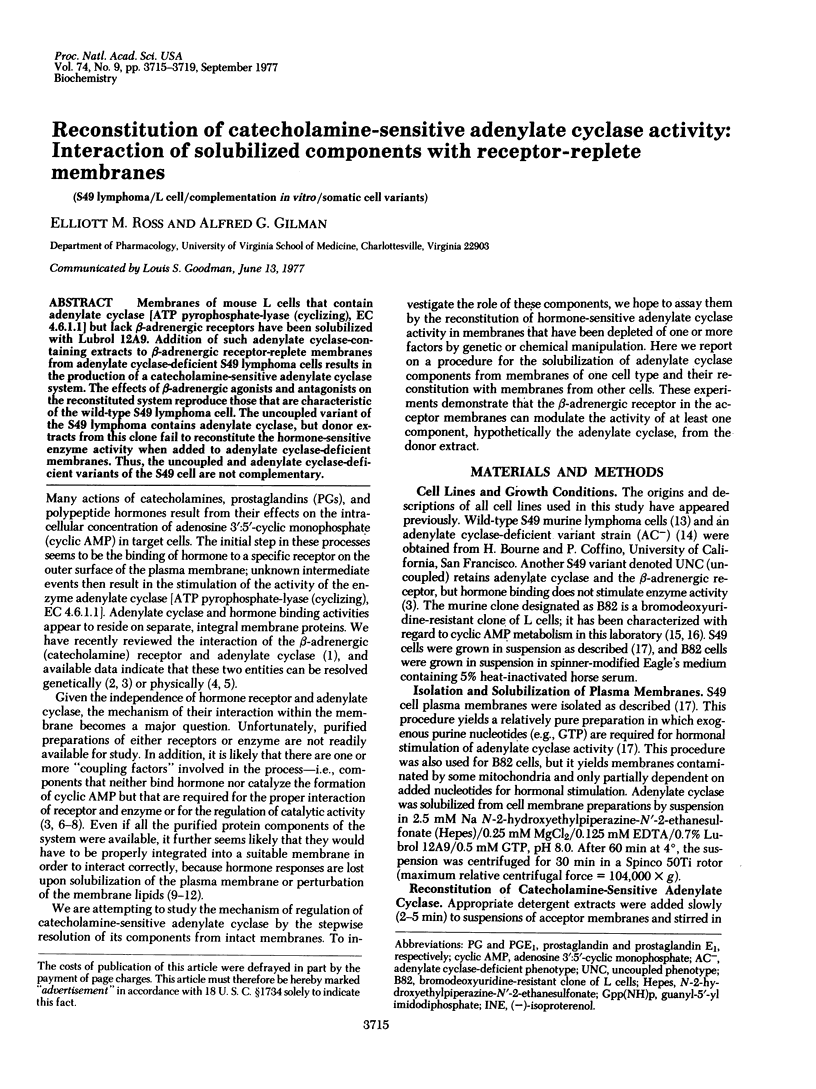
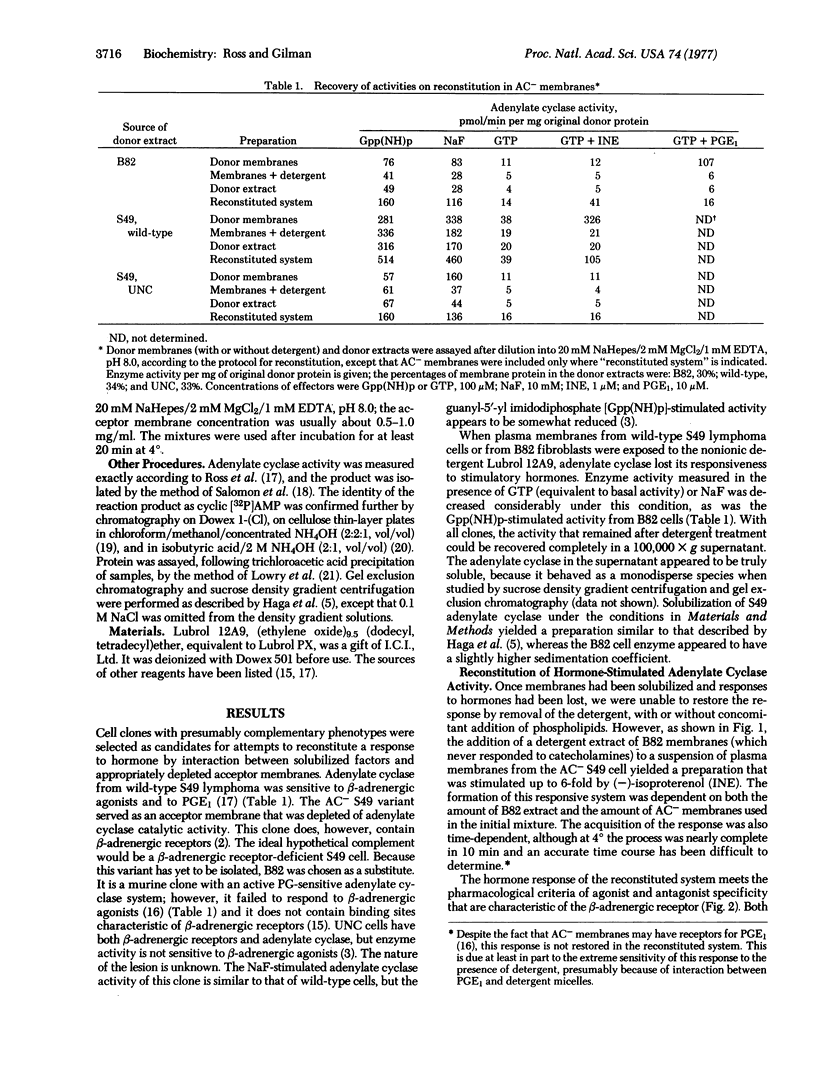
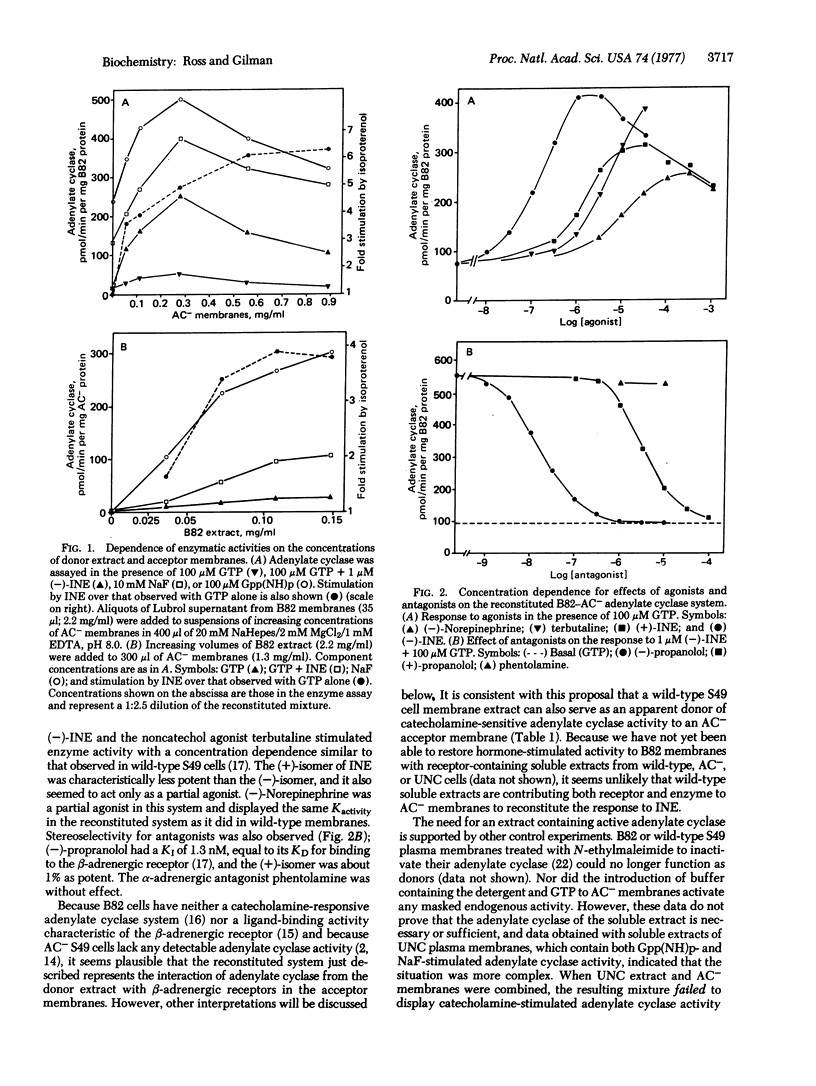
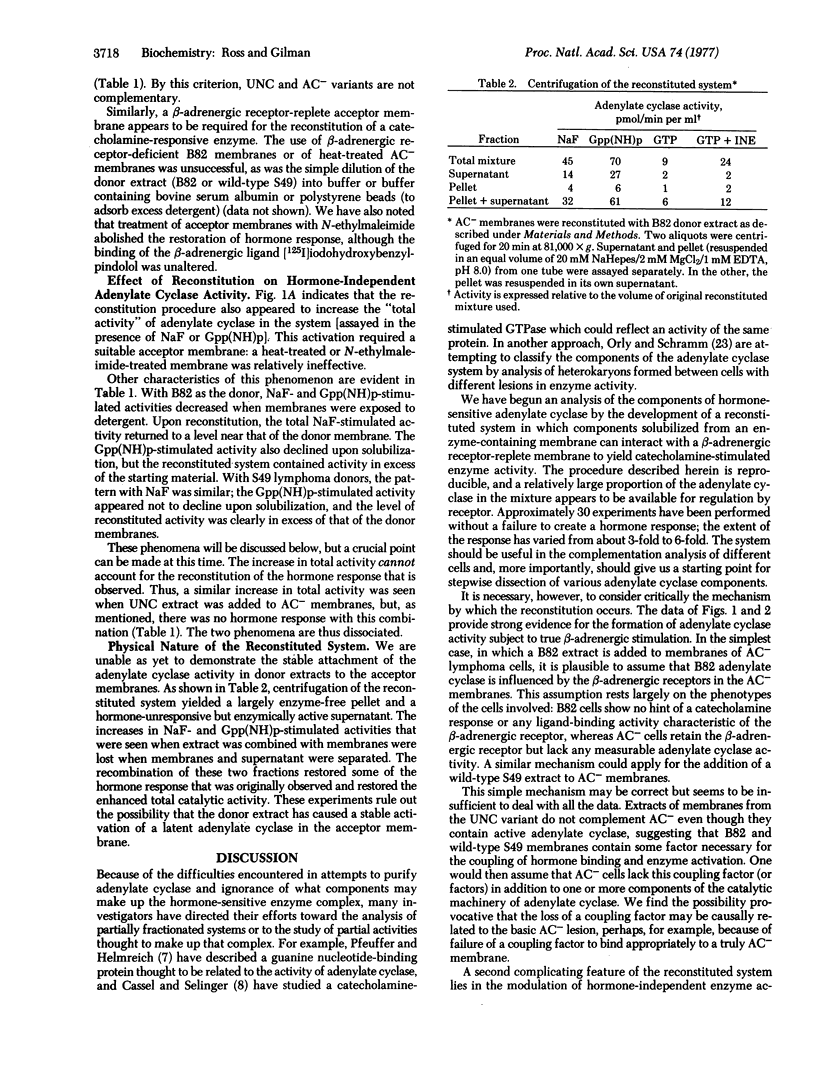
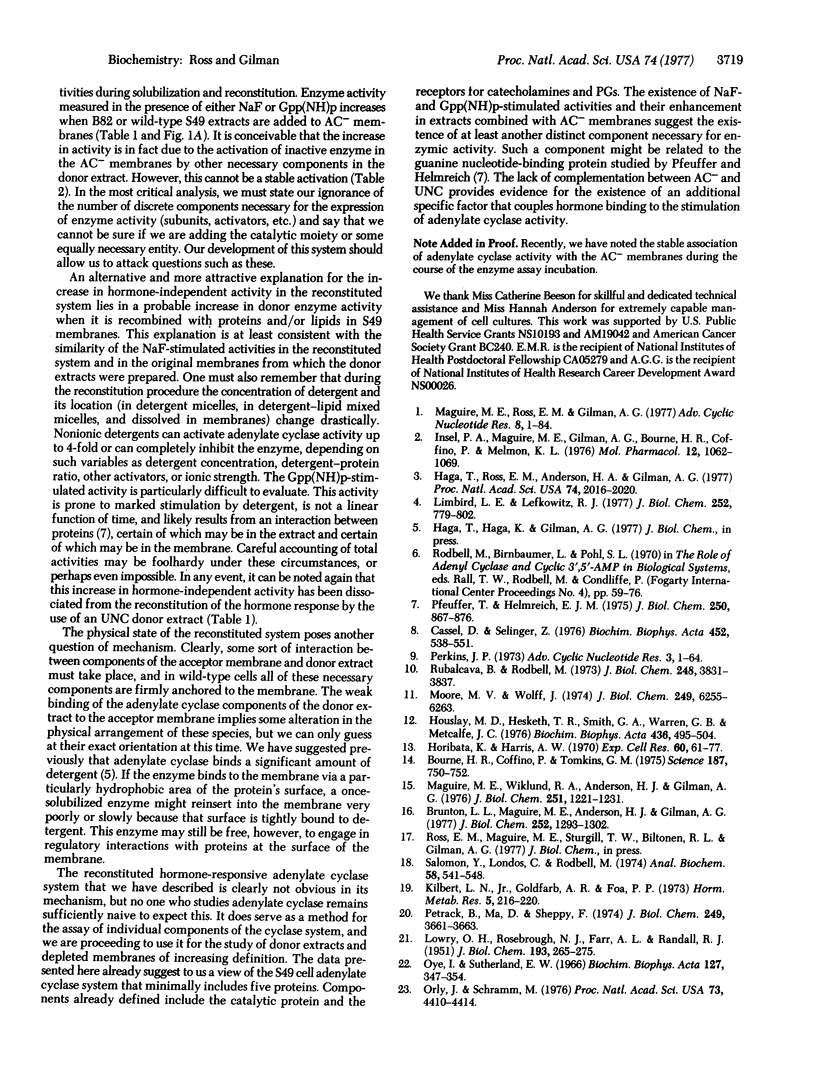
Selected References
These references are in PubMed. This may not be the complete list of references from this article.
- Bourne H. R., Coffino P., Tomkins G. M. Selection of a variant lymphoma cell deficient in adenylate cyclase. Science. 1975 Feb 28;187(4178):750–752. doi: 10.1126/science.163487. [DOI] [PubMed] [Google Scholar]
- Brunton L. L., Maguire M. E., Anderson H. J., Gilman A. G. Expression of genes for metabolism of cyclic adenosine 3':5'-monophosphate in somatic cells. beta-Adrenergic and PGE1 receptors in parental and hybrid cells. J Biol Chem. 1977 Feb 25;252(4):1293–1302. [PubMed] [Google Scholar]
- Cassel D., Selinger Z. Catecholamine-stimulated GTPase activity in turkey erythrocyte membranes. Biochim Biophys Acta. 1976 Dec 8;452(2):538–551. doi: 10.1016/0005-2744(76)90206-0. [DOI] [PubMed] [Google Scholar]
- Haga T., Ross E. M., Anderson H. J., Gilman A. G. Adenylate cyclase permanently uncoupled from hormone receptors in a novel variant of S49 mouse lymphoma cells. Proc Natl Acad Sci U S A. 1977 May;74(5):2016–2020. doi: 10.1073/pnas.74.5.2016. [DOI] [PMC free article] [PubMed] [Google Scholar]
- Horibata K., Harris A. W. Mouse myelomas and lymphomas in culture. Exp Cell Res. 1970 Apr;60(1):61–77. doi: 10.1016/0014-4827(70)90489-1. [DOI] [PubMed] [Google Scholar]
- Houslay M. D., Hesketh T. R., Smith G. A., Warren G. B., Metcalfe J. C. The lipid environment of the glucagon receptor regulates adenylate cyclase activity. Biochim Biophys Acta. 1976 Jun 17;436(2):495–504. doi: 10.1016/0005-2736(76)90211-x. [DOI] [PubMed] [Google Scholar]
- Insel P. A., Maguire M. E., Gilman A. G., Bourne H. R., Coffino P., Melmon K. L. Beta adrenergic receptors and adenylate cyclase: products of separate genes? Mol Pharmacol. 1976 Nov;12(6):1062–1069. [PubMed] [Google Scholar]
- Kilbert L. H., Jr, Goldfarb A. R., Foà P. P. A micro-method for the measurement of pharmacologically induced changes in purine derivatives. Horm Metab Res. 1973 May;5(3):216–220. doi: 10.1055/s-0028-1093956. [DOI] [PubMed] [Google Scholar]
- LOWRY O. H., ROSEBROUGH N. J., FARR A. L., RANDALL R. J. Protein measurement with the Folin phenol reagent. J Biol Chem. 1951 Nov;193(1):265–275. [PubMed] [Google Scholar]
- Limbird L. E., Lefkowitz R. J. Resolution of beta-adrenergic receptor binding and adenylate cyclase activity by gel exclusion chromatography. J Biol Chem. 1977 Jan 25;252(2):799–802. [PubMed] [Google Scholar]
- Maguire M. E., Ross E. M., Gilman A. G. beta-Adrenergic receptor: ligand binding properties and the interaction with adenylyl cyclase. Adv Cyclic Nucleotide Res. 1977;8:1–83. [PubMed] [Google Scholar]
- Maguire M. E., Wiklund R. A., Anderson H. J., Gilman A. G. Binding of (125I)iodohydroxybenzylpindolol to putative beta-adrenergic receptors of rat glioma cells and other cell clones. J Biol Chem. 1976 Mar 10;251(5):1221–1231. [PubMed] [Google Scholar]
- Moore W. V., Wolff J. Thyroid-stimulating hormone binding to beef thyroid membranes. Relation to adenylate cyclase activity. J Biol Chem. 1974 Oct 10;249(19):6255–6263. [PubMed] [Google Scholar]
- Orly J., Schramm M. Coupling of catecholamine receptor from one cell with adenylate cyclase from another cell by cell fusion. Proc Natl Acad Sci U S A. 1976 Dec;73(12):4410–4414. doi: 10.1073/pnas.73.12.4410. [DOI] [PMC free article] [PubMed] [Google Scholar]
- Oye I., Sutherland E. W. The effect of epinephrine and other agents on adenyl cyclase in the cell membrane of avian erythrocytes. Biochim Biophys Acta. 1966 Oct 31;127(2):347–354. doi: 10.1016/0304-4165(66)90389-8. [DOI] [PubMed] [Google Scholar]
- Perkins J. P. Adenyl cyclase. Adv Cyclic Nucleotide Res. 1973;3:1–64. [PubMed] [Google Scholar]
- Petrack B., Ma D., Sheppy F. Formation of a novel nucleotide by fat cell preparations containing adenylate cyclase. J Biol Chem. 1974 Jun 10;249(11):3661–3663. [PubMed] [Google Scholar]
- Pfeuffer T., Helmreich E. J. Activation of pigeon erythrocyte membrane adenylate cyclase by guanylnucleotide analogues and separation of a nucleotide binding protein. J Biol Chem. 1975 Feb 10;250(3):867–876. [PubMed] [Google Scholar]
- Rubalcava B., Rodbell M. The role of acidic phospholipids in glucagon action on rat liver adenylate cyclase. J Biol Chem. 1973 Jun 10;248(11):3831–3837. [PubMed] [Google Scholar]
- Salomon Y., Londos C., Rodbell M. A highly sensitive adenylate cyclase assay. Anal Biochem. 1974 Apr;58(2):541–548. doi: 10.1016/0003-2697(74)90222-x. [DOI] [PubMed] [Google Scholar]


